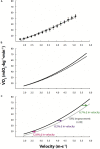Extrapolating Metabolic Savings in Running: Implications for Performance Predictions
- PMID: 30804807
- PMCID: PMC6378703
- DOI: 10.3389/fphys.2019.00079
Extrapolating Metabolic Savings in Running: Implications for Performance Predictions
Abstract
Training, footwear, nutrition, and racing strategies (i.e., drafting) have all been shown to reduce the metabolic cost of distance running (i.e., improve running economy). However, how these improvements in running economy (RE) quantitatively translate into faster running performance is less established. Here, we quantify how metabolic savings translate into faster running performance, considering both the inherent rate of oxygen uptake-velocity relation and the additional cost of overcoming air resistance when running overground. We collate and compare five existing equations for oxygen uptake-velocity relations across wide velocity ranges. Because the oxygen uptake vs. velocity relation is non-linear, for velocities slower than ∼3 m/s, the predicted percent improvement in velocity is slightly greater than the percent improvement in RE. For velocities faster than ∼3 m/s, the predicted percent improvement in velocity is less than the percent improvements in RE. At 5.5 m/s, i.e., world-class marathon pace, the predicted percent improvement in velocity is ∼2/3rds of the percent improvement in RE. For example, at 2:04 marathon pace, a 3% improvement in RE translates to a 1.97% faster velocity or 2:01:36, almost exactly equal to the recently set world record.
Keywords: energetic cost; locomotion; marathon; oxygen uptake; running economy.
Figures


Similar articles
-
The metabolic cost of emulated aerodynamic drag forces in marathon running.J Appl Physiol (1985). 2022 Sep 1;133(3):766-776. doi: 10.1152/japplphysiol.00086.2022. Epub 2022 Jul 14. J Appl Physiol (1985). 2022. PMID: 35834628
-
Technological advances in elite marathon performance.J Appl Physiol (1985). 2021 Jun 1;130(6):2002-2008. doi: 10.1152/japplphysiol.00002.2021. Epub 2021 May 13. J Appl Physiol (1985). 2021. PMID: 33982594
-
A Comparison of the Energetic Cost of Running in Marathon Racing Shoes.Sports Med. 2018 Apr;48(4):1009-1019. doi: 10.1007/s40279-017-0811-2. Sports Med. 2018. PMID: 29143929 Free PMC article.
-
How Biomechanical Improvements in Running Economy Could Break the 2-hour Marathon Barrier.Sports Med. 2017 Sep;47(9):1739-1750. doi: 10.1007/s40279-017-0708-0. Sports Med. 2017. PMID: 28255937 Review.
-
Applied physiology of marathon running.Sports Med. 1985 Mar-Apr;2(2):83-99. doi: 10.2165/00007256-198502020-00002. Sports Med. 1985. PMID: 3890068 Review.
Cited by
-
Analysis of hip joint loading during walking with different shoe types using instrumented total hip prostheses.Sci Rep. 2021 May 12;11(1):10073. doi: 10.1038/s41598-021-89611-8. Sci Rep. 2021. PMID: 33980984 Free PMC article.
-
Influence of Shoe Mass on Performance and Running Economy in Trained Runners.Front Physiol. 2020 Sep 23;11:573660. doi: 10.3389/fphys.2020.573660. eCollection 2020. Front Physiol. 2020. PMID: 33071828 Free PMC article.
-
Physiological Predictors of Maximal Incremental Running Performance.Front Physiol. 2020 Aug 5;11:979. doi: 10.3389/fphys.2020.00979. eCollection 2020. Front Physiol. 2020. PMID: 32848890 Free PMC article.
-
Gender differences in footwear characteristics between half and full marathons in China: a cross-sectional survey.Sci Rep. 2023 Aug 10;13(1):13020. doi: 10.1038/s41598-023-39718-x. Sci Rep. 2023. PMID: 37563273 Free PMC article.
-
Variability in Running Economy of Kenyan World-Class and European Amateur Male Runners with Advanced Footwear Running Technology: Experimental and Meta-analysis Results.Sports Med. 2023 Jun;53(6):1255-1271. doi: 10.1007/s40279-023-01816-1. Epub 2023 Mar 2. Sports Med. 2023. PMID: 36862339 Free PMC article.
References
LinkOut - more resources
Full Text Sources

